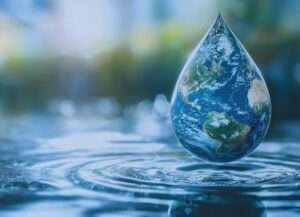Water traveling from municipal sources to a building’s taps undergoes a complex journey influenced by everything from the quality of the source water to the building’s internal distribution network. Even water that meets national safety standards can encounter challenges as it passes through aging pipes, is affected by shifting climates, and interacts with building infrastructure. Understanding these factors—and taking proactive steps to address them—is essential for ensuring safe, reliable, and sustainable water.
Understanding source water quality
The foundation of safe drinking water in the U.S. is the Safe Drinking Water Act (SDWA), which mandates the EPA to set health-based standards for public water supplies. While compliance with SDWA ensures water is safe to consume, it doesn’t guarantee that water entering a building’s plumbing system is free of all contaminants or pathogens. Once water leaves the municipal water treatment plant and enters the distribution system, the quality of the water can change drastically before it reaches a building, leaving building water systems susceptible to issues like scale, corrosion, and even microbial growth.
Growing challenges influencing source water quality
- Aging infrastructure: The American Society of Civil Engineers estimates there are 240,000 water main breaks yearly, wasting over two trillion gallons of treated water. Corroding pipelines exacerbate this issue and introduce contaminants like rust, sediment, and biofilm into municipal water supplies. These disruptions compromise water quality at the source and increase the risk of microbiological growth in building systems. The result? Degraded water quality, rising maintenance costs, and potential health risks for building occupants.
- Environmental factors: Extreme weather events like heavy rainfall and flooding are introducing higher levels of contaminants into source water, overwhelming treatment plants and degrading the quality of water delivered to buildings. Simultaneously, rising ambient temperatures are heating cold water systems, accelerating biological activity and creating ideal conditions for pathogens like Legionella to proliferate. Seasonal changes in temperature can also warm source water. These changes demand proactive water management strategies to protect building water systems from the evolving risks posed by climate change.
Leveraging water quality reports
Consumer Confidence Reports (CCRs) are annual water quality reports issued by municipalities to inform consumers about the safety and quality of their drinking water. By reviewing these reports, engineers and facility managers can anticipate challenges such as scaling, corrosion, or bacterial growth and adjust water treatment protocols accordingly.
- Chlorine residuals: Indicates the amount of disinfectant remaining in the water. Low levels can lead to microbial growth, while excessive levels may increase the risk of disinfection byproducts.
- Turbidity: Measures water clarity and the presence of particulates. High turbidity levels can harbor bacteria and hinder disinfection processes. turbidity may signal a need for enhanced filtration.
- Temperature and pH: These factors influence water chemistry, microbial activity, and corrosion potential.
How source water quality impacts buildings
- Opportunistic pathogens: Municipal processes effectively address fecal pathogens like E. coli but are less effective against opportunistic bacteria like Legionella and Pseudomonas. These microbes can survive treatment and multiply within building systems, especially in warm, stagnant water.
- Corrosion and scale: Water mains can release rust and corrosion products, which enter plumbing systems and settle there, causing colored water and stains. Additionally, hard water can cause significant scaling issues throughout the building water system.
- Disinfection byproducts (DBPs): Chemicals like chlorine and chloramine, used to disinfect water, can form harmful byproducts when they interact with organic material. These byproducts pose health risks and complicate water treatment within buildings. As the treated water travels to the building, disinfectant residuals from the municipal treatment decrease, leading to an increased risk of Legionella and waterborne pathogen amplification.
Solutions for optimal water quality
To mitigate risks and ensure high-quality water throughout building systems, you must adopt proactive and multi-faceted strategies. Here are some proven solutions:
1. Supplemental disinfection systems:
Installing secondary disinfection systems can help control microbial growth beyond the municipal supply. Options like UV disinfection can target pathogens like Legionella without contributing to harmful DBPs or accelerating corrosion.
2. Flushing programs:
Regular flushing of plumbing systems removes stagnant water, sediment, and biofilm. A well-designed flushing program includes low-use fixtures, distal outlets, and hot water recirculation loops to prevent microbial growth and ensure disinfectant efficacy.
3. Sediment filtration:
Point-of-entry sediment filtration systems capture particulates and sediment before they enter the building’s plumbing, reducing strain on equipment, minimizing scale formation, and improving water clarity.
4. Water softeners:
By reducing hardness, softeners prevent scaling and improve the efficiency of water-dependent systems. This is particularly critical in areas with high sediment or hard water.
5. Smart monitoring:
Modern IoT-enabled sensors can provide real-time insights into water quality metrics such as temperature, pH, chlorine residuals, and microbial activity. Automated alerts enable facility teams to respond quickly to emerging issues.
Standards, best practices, and emerging trends
Standards and best practices
Several modern guidelines provide a framework for water quality management:
- ASHRAE Standards 188 and 514: These standards focus on managing risks from Legionella and other physical, chemical, and microbial hazards.
- WELL Building Standard: Emphasizes water quality as a fundamental component of occupant health, focusing on pathogen control, transparency, and proactive management.
- EPA Guidelines: Mandate transparency through CCRs and provide updated recommendations for disinfection practices and contaminant monitoring.
Emerging trends
- Balancing water conservation with safety: Green building initiatives are driving the adoption of water-saving measures, which can inadvertently increase water age and stagnation risks. Balancing sustainability with water quality will be a critical challenge for future building designs.
- Smart technologies: The integration of smart technologies with these standards will help buildings adapt to changing water quality conditions in real-time, enhancing resilience and occupant health.
Making water quality a strategic priority
Water quality is not just a technical challenge—it’s a strategic priority. Poor water quality can compromise building performance, increase operational costs, and endanger occupant health. By leveraging tools like CCRs, adhering to best practices, and investing in advanced water management solutions, you can ensure that your water systems deliver safe, efficient, and sustainable water.
Partner with LiquiTech to lead the way in advanced water intelligence. Together, we can transform your building’s water systems. Contact us today to get started.


